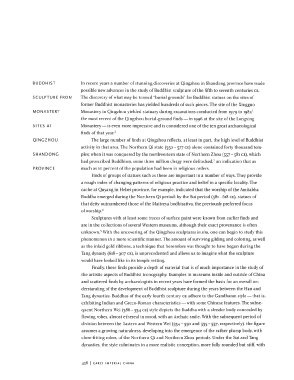Page 439 - The Golden Age of Chinese Archaeology: Celebrated Discoveries from the People’s Republic of China
P. 439
BUDDHIST In recent years a number of stunning discoveries at Qingzhou in Shandong province have made
possible new advances in the study of Buddhist sculpture of the fifth to seventh centuries CE.
SCULPTURE FROM The discovery of what may be termed "burial grounds" for Buddhist statues on the sites of
former Buddhist monasteries has yielded hundreds of such pieces. The site of the Xingguo
MONASTERY Monastery in Qingzhou yielded statuary during excavations conducted from 1979 to igSi; 1
the most recent of the Qingzhou burial-ground finds — in 1996 at the site of the Longxing
SITES AT Monastery — is even more impressive and is considered one of the ten great archaeological
finds of that year. 2
QINGZHOU, The large number of finds at Qingzhou reflects, at least in part, the high level of Buddhist
activity in that area. The Northern Qi state (550-577 CE) alone contained forty thousand tem-
SHANDONG ples; when it was conquered by the northwestern state of Northern Zhou (557-581 CE), which
had proscribed Buddhism, some three million clergy were defrocked, 3 an indication that as
PROVINCE much as 10 percent of the population had been in religious orders.
Finds of groups of statues such as these are important in a number of ways. They provide
a rough index of changing patterns of religious practice and belief in a specific locality. The
cache at Quyang in Hebei province, for example, indicated that the worship of the Amitabha
Buddha emerged during the Northern Qi period; by the Sui period (581-618 CE), statues of
that deity outnumbered those of the Maitreya bodhisattva, the previously preferred focus
of worship. 4
Sculptures with at least some traces of surface paint were known from earlier finds and
are in the collections of several Western museums, although their exact provenance is often
5
unknown. With the uncovering of the Qingzhou sculptures in situ, one can begin to study this
phenomenon in a more scientific manner. The amount of surviving gilding and coloring, as well
as the inlaid gold ribbons, a technique that heretofore was thought to have begun during the
Tang dynasty (618-907 CE), is unprecedented and allows us to imagine what the sculpture
would have looked like in its temple setting.
Finally, these finds provide a depth of material that is of much importance in the study of
the artistic aspects of Buddhist iconography. Examples in museums inside and outside of China
and scattered finds by archaeologists in recent years have formed the basis for an overall un-
derstanding of the development of Buddhist sculpture during the years between the Han and
Tang dynasties. Buddhas of the early fourth century CE adhere to the Gandharan style — that is,
exhibiting Indian and Greco-Roman characteristics — with some Chinese features. The subse-
quent Northern Wei (386-534 CE) style depicts the Buddha with a slender body concealed by
flowing robes, almost ethereal in mood, with an Archaic smile. With the subsequent period of
division between the Eastern and Western Wei (534-550 and 535-557, respectively), the figure
assumes a growing naturalness, developing into the emergence of the rather plump body, with
close-fitting robes, of the Northern Qi and Northern Zhou periods. Under the Sui and Tang
dynasties, the style culminates in a more realistic conception, more fully rounded but stiff, with
438 E A R L Y I M P E R I A L C H I N A

